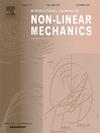一种分段动磁结构的非线性多稳定电磁能量采集器
IF 2.8
3区 工程技术
Q2 MECHANICS
International Journal of Non-Linear Mechanics
Pub Date : 2025-07-03
DOI:10.1016/j.ijnonlinmec.2025.105203
引用次数: 0
摘要
基于磁悬浮的能量采集器可以表现出强烈的软化和硬化非线性,从而扩展了工作带宽。通过在中心位置引入固定磁体并调整磁极方向,可以系统地实现双稳或三稳电位分布。这些多稳定配置有利于大幅度振荡,从而增强通过机电转导产生的电压输出。然而,之前的研究分别考虑了每种磁相互作用结构,而没有基于关键系统参数分析或比较它们的能量收集性能,例如确定每种结构在最佳状态下的特定激励条件。此外,在许多研究中,动态行为仅通过电压测量来评估,而没有直接量化振荡幅度。在这项研究中,我们研究了由吸引和排斥磁相互作用引起的恢复力如何影响系统动力学。理论分析表征了与每种构型相关的恢复力行为。采用有限元方法对恢复力进行了模拟,并通过静载试验验证了理论预测。电磁原型实现排斥和吸引配置制造和实验测试。结果显示出明显的多稳定特性。具体来说,在相同的条件下,除了移动子磁体的极性方向外,所有系统参数都是固定的,在低加速度水平(小于1g)下,排斥性配置更有效地收集能量,而吸引力配置在高加速度水平(大于1g)下表现更好。本文章由计算机程序翻译,如有差异,请以英文原文为准。
A nonlinear multi-stable electromagnetic energy harvester with segmented moving magnet configuration
Magnetic-levitation-based energy harvesters can exhibit both strong softening and hardening nonlinearities, enabling an extended operational bandwidth. By introducing stationary magnets at center positions and tailoring the poling directions, bistable or tristable potential profiles can be systematically realized. These multi-stable configurations facilitate large-amplitude oscillations, thereby enhancing the voltage output generated via electromechanical transduction. However, previous studies have considered each magnetic interaction configuration separately, without analyzing or comparing their energy harvesting performance based on critical system parameters, such as identifying the specific excitation conditions under which each configuration performs optimally. Furthermore, the dynamic behavior in many of these studies is assessed solely through voltage measurements, without direct quantification of oscillation amplitude. In this study, we investigate how the restoring forces induced by attractive and repulsive magnetic interactions influence the system dynamics. Theoretical analysis is conducted to characterize the restoring force behavior associated with each configuration. Finite element method (FEM) simulations are performed to model the restoring forces, and the theoretical predictions are validated through static loading experiments. Electromagnetic prototypes implementing both repulsive and attractive configurations are fabricated and experimentally tested. The results demonstrate distinct multi-stable characteristics. Specifically, under identical conditions in which all system parameters are fixed except for the poling direction of a moving sub-magnet, the repulsive configuration is more effective for energy harvesting at low acceleration levels (less than 1 g), while the attractive configuration performs better at higher acceleration levels (greater than 1 g).
求助全文
通过发布文献求助,成功后即可免费获取论文全文。
去求助
来源期刊
CiteScore
5.50
自引率
9.40%
发文量
192
审稿时长
67 days
期刊介绍:
The International Journal of Non-Linear Mechanics provides a specific medium for dissemination of high-quality research results in the various areas of theoretical, applied, and experimental mechanics of solids, fluids, structures, and systems where the phenomena are inherently non-linear.
The journal brings together original results in non-linear problems in elasticity, plasticity, dynamics, vibrations, wave-propagation, rheology, fluid-structure interaction systems, stability, biomechanics, micro- and nano-structures, materials, metamaterials, and in other diverse areas.
Papers may be analytical, computational or experimental in nature. Treatments of non-linear differential equations wherein solutions and properties of solutions are emphasized but physical aspects are not adequately relevant, will not be considered for possible publication. Both deterministic and stochastic approaches are fostered. Contributions pertaining to both established and emerging fields are encouraged.

 求助内容:
求助内容: 应助结果提醒方式:
应助结果提醒方式:


